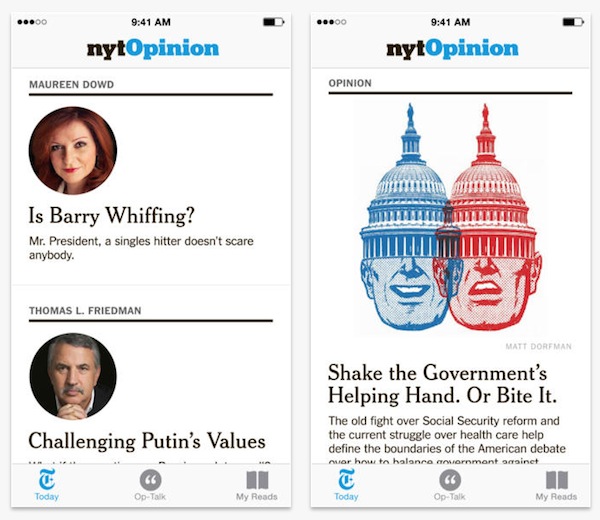
This week’s essential reads: The key pieces to read this week are The Atlantic’s Robinson Meyer on the NYT Opinion app, Alexander Howard’s report on data-driven journalism, and Spencer Ackerman and Trevor Timm at The Guardian on the Edward Snowden documents a year later.
James Risen’s case hits a wall: New York Times reporter James Risen’s long legal battle against being forced to reveal the name of a confidential source in legal testimony reached a dead end in the courts this week. The U.S. Supreme Court declined to hear his appeal of a federal ruling against him, leaving the matter up to the Department of Justice to resolve.
As the Times reported, it’s now up to the Justice Department to determine whether it wants to compel him to testify — and jail him if he refuses. The Obama administration has sent mixed signals: In its brief on the case, it said reporters have no privilege to refuse to testify about confidential sources, but Attorney General Eric Holder reportedly told journalists last week that no reporter doing his or her job will go to jail.
Risen vowed to continue to fight, but as The Washington Post’s Erik Wemple noted, he’s already been fighting for six years, and even if the government pulls up short of forcing jail time now, it still may leave a real chilling effect on the press. Wemple also gave some background on the legal case, as did Fortune’s Roger Parloff, who argued for the Supreme Court to take the case.
USA Today’s Rem Rieder expressed his hope that Risen’s setback would spur Congress to pass a shield law protecting journalists from testifying. And late last week, ABC News’ Mike Levine revealed that he had been subpoenaed by the government to reveal a confidential source in 2011 when he worked for Fox News, but the Justice Department dropped the fight after just more than a year. The New York Times added some background on Levine’s case and the shield law fight.

The plan behind NYT Opinion: The New York Times launched its second specialized subscription app (after NYT Now this spring) this week: A new opinion-only app called NYT Opinion. It’ll cost $6 per four weeks, and the app will include two main streams: One of all the Times’ columnists and op-ed pieces, and the other called Op-Talk which will offer a selection of opinion from around the web chosen by Times editors. Between the Op-Talk feature and NYT Now’s aggregative approach, as TechCrunch’s Ingrid Lunden noted, the Times seems to be trying to position itself as an aggregator, but it in a way that separates its own content from the web’s.
The app is the first of the Times’ new digital subscription options to focus on a particular content type, but it’s not the first time the Times has charged specifically for its opinion content: From 2005 to 2007, it put its opinion content behind a paywall called TimesSelect. The Atlantic’s Robinson Meyer examined the differences between this effort and that one (it’s not a hard paywall — that’s the big one), and wondered who this app is intended for. The answer from the Times was that it’s for people who are already up on the news, but are particularly interested in the Times’ op-ed content.
Meyer wondered if NYT Opinion could be compared to Slate’s membership program Slate Plus, with both banking on a long-standing reputation for compelling opinions as the once-exploding blogosphere starts to get gobbled up by established media outlets. “Maybe there’s an opening now for readers to support the institutions—and the voices—they come back to. NYT Opinion provides just that,” he wrote.
The Awl’s Matt Buchanan said that as the Times gets unbundled in app form, it’s worth questioning whether each chunk can stand on its own as well as they all did as a whole. Writer and designer Craig Mod, meanwhile, gave NYT Now an enthusiastic review, and media analyst Steve Outing wondered what would happen if the Times cut its print edition.

A set of Apple announcements: Apple made a slew of product announcements this week in its keynote at its annual developers’ conference. If you want to know all about all of them, you can dive into the couple hundred posts pulled together on Techmeme, but here’s a quick rundown: Apple unveiled a new iOS (iOS 8) for its mobile devices, a new operating system for its desktops (OS X Yosemite), a new programming language (Swift), a new file-sharing system (iCloud Drive), a new smart home framework (HomeKit), a new health API for developers (HealthKit), and a revamped messaging system.
A few of the more substantive posts coming out of that set of announcements: Fast Company’s Chris Dannen looked at Swift’s move toward the more popular scripting languages of the web like JavaScript and Python, and The Verge’s Ben Popper wrote about the idea that this shift will draw a larger pool of iOS developers. The Atlantic’s Megan Garber looked at HomeKit as Apple’s attempt to standardize the world of objects as it moves into “the Internet of things,” and TechCrunch’s Ingrid Lunden pointed out the increasing centrality of search for Apple and the simultaneous crowding out of Google in its products.
Southern California newspaper setback: Just two months after it launched a new daily paper in Los Angeles, Freedom Communications, the owner of the Orange County Register and Los Angeles Register, announced a range of cuts this week, including a merger of the Long Beach Register, which it launched last year, with its L.A. paper, mandatory two-week furloughs, buyouts intended to cut 100 jobs, and a 25 percent drop in print news space.
In a typically authoritative analysis, the Lab’s Ken Doctor described the changes as “a big red flag, screaming we’re running out of money really soon, following numerous months of yellow flags.” Journalism professor Dan Kennedy said that the signs don’t look good for the strategy of Freedom owner Aaron Kushner, and his pockets aren’t as deep as other recent news investors, like The Boston Globe’s John Henry, to ride out the rough patches of local newspaper experimentation. USA Today’s Rem Rieder commended Kushner for trying his bold plan, but said the odds of its success are getting longer.Reading roundup: There was quite a few other interesting developments and conversations happening this week. Here’s a quick rundown:
— A year after Edward Snowden released his trove of documents on U.S. National Security Agency surveillance, The Guardian’s Spencer Ackerman took stock of where the issue stands and Trevor Timm of the Freedom of the Press Foundation looked at four ways Snowden’s act changed the landscape of surveillance and cybersecurity. The Guardian launched a leaking platform for whistleblowers called SecureDrop, and Microsoft called on the U.S. government to end bulk data collection.
— The American Prospect announced last week that it’s shifting back to its roots as a quarterly policy journal, scaling back its digital operation and laying off or losing most of its staff. Vox’s Ezra Klein, an American Prospect alum, reflected on the outsized influence the Prospect had on online policy news and commentary, and The Washington Post’s Alyssa Rosenberg looked at the difficulty of being an incubator for online journalism as the Prospect was.
— Two fantastic resources on data and journalism were published in the past week: The Tow Center’s Alexander Howard’s extensive report (summary and PDF) on how data-driven journalism is done, and Microsoft researcher Kate Crawford on the anxieties of big data.
— A couple of other interesting studies released this week: The Tow Center published a study on the use of user-generated content in global TV and online news, and a group of organizations led by the Digital Media Law Project released a study examining who gets press credentials (and who doesn’t) and why. You can read pieces on the study at the Columbia Journalism Review and here at the Lab.— Finally, two fascinating peeks behind the curtain at NPR: Melody Kramer described at Source how she and Wright Bryan developed a data analytics dashboard for NPR journalists, and Brian Boyer explained how the NPR visuals team works.